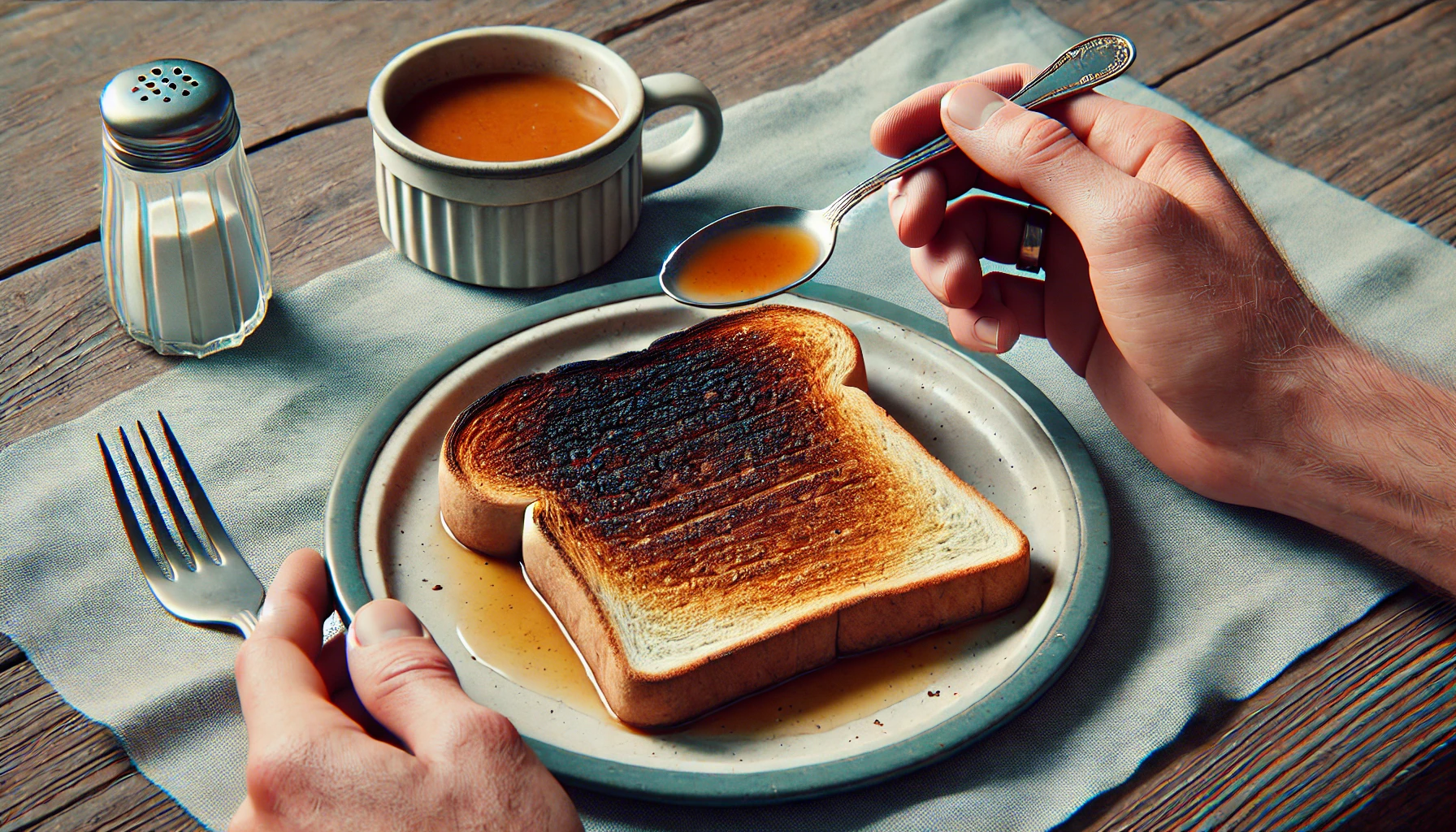Burnt toast and other foods that have been blackened from cooking, produces a chemical called acrylamide which in animal studies has been linked to cancer, but so far not in humans. The risk of cancer from eating burnt toast appears exceedingly low when compared to other much more impotant lifestyle factors. This consensus is based on 5 experts answers from this question: Is eating burnt toast a cancer risk?
In January of 2018, UK’s Food Standard Agency launched a consumer campaign warning about potential cancer risks from eating burnt toast, roasted potatoes and other starchy foods cooked at high temperatures. Time to panic? Despite the not unpredictable media headlines, no need to panic just yet.
The health warning reprised concerns about the long-known potentially harmful chemical of acrylamide. Acrylamide is naturally found in starchy foods and is formed during cooking as part of the Maillard reaction which turns food a lovely golden-brown colour. Acrylamide formation chiefly occurs when foods with a high starch content such as potatoes, root vegetables and bread, are cooked at temperatures over 120°C during frying, roasting or baking.
The recent concerns about reducing acrylamide exposure are based on long-standing evidence from animal studies linking the chemical to cancer. But so far in humans, the same link has yet to be seen. Still, in 2005, a joint FAO/WHO Expert Committee on Food Additives concluded that there is a possibility of human health concerns with acrylamide even with our generally low intake.
How the media portrayed the news
How the media ran with health concerns about acrylamide is where burnt toast entered the picture. Here’s a collection of some of the headlines: How burnt toast and roast potatoes became linked to cancer (The Guardian), Can burnt toast and roasted potatoes cause cancer? (CNN) and Experts in the UK reveal how roast potatoes, toast and hot chips might lead to cancer (News Ltd).
The most surprising thing about the headlines was that there was nothing new in them that health and food regulatory bodies in Australia, the United States and Europe have not raised before. The new angle was the stronger wording of the risk and clearly defined advice on reducing exposure.
Learn more with Consensus AI Academic Search Engine:
🍞What is acrylamide and how is it formed in food? ✍🏻What have animal studies shown about the link between acrylamide and cancer? 🎥How have media headlines portrayed the cancer risk associated with acrylamide in burnt toast? 🥔Can storing potatoes in the fridge increase acrylamide levels when they are cooked?The truth: the research findings
The cancer fears from acrylamide come almost exclusively from rat studies. So perhaps if you keep rats as pets, it would be best not to feed them burnt toast. There is no firm research linking acrylamide found naturally in food to cancer in humans. But the possibility cannot be excluded. A recent systematic review and meta-analysis concluded that dietary acrylamide is not related to the risk of most common cancers in humans so if there is a risk, it is likely very small.
The American Cancer Society lists acrylamide as a ‘probable carcinogen’. A list of things in our environment that are probable carcinogens would be so long that it would make a person retreat into a bunker and never surface again. Cancer risk is all about appreciating the big players for the ones you can control. Smoking, alcohol, physical inactivity, too much sun, obesity and a poor diet are at the top of the list.
As Dirk Lachenmeir from the Chemical and Veterinary Investigation Agency Karlsruhe noted, there may certainly be a cancer hazard from burnt toast (due to acrylamide and other heat-induced compounds), however, the risk appears to be quite low compared to other lifestyle choices such as alcohol drinking or tobacco smoking. Pelle Olesen from the Technical University of Denmark also stated that the amounts of acrylamide ingested through the diet are small.
Learn more with Consensus AI Academic Search Engine:
⚗️Are the cancer risks from acrylamide higher than those from smoking or alcohol consumption? 🏦Does the American Cancer Society list acrylamide as a probable carcinogen?How to eat less acrylamide
While toast contains less acrylamide than potato chips and fries per serve, because toasted white bread is one of the main food sources of acrylamide, it is the food that has attracted the headlines. Work done by Food Standards Australia and New Zealand estimated dietary acrylamide exposure of Australians is in the range considered to be of possible concern to human health so it is certainly worth considering how someone could lower their exposure. Here’s how to do it.
- Aim for a yellow or golden-brown colour when frying, roasting or baking food
- Toast bread or other foods to the lightest colour acceptable to your taste, noting that the crust will have higher levels of acrylamide
- Avoid keeping potatoes in the fridge before cooking them, as this can further increase acrylamide levels
- Soak potatoes in water for 15-30 minutes, or blanch in boiling water before frying or roasting. This reduces the components that promote acrylamide formation
- Follow cooking instructions on food packages to avoid overcooking.
There are thousands of things linked to cancer, so risk needs to be put into perspective and for burnt toast, the risk is very small, if at all. The important things to focus on are eating a healthy diet, being more active and drinking less alcohol and not smoking.
Learn more with Consensus AI Academic Search Engine:
🧪What recommendations are given to reduce acrylamide exposure when cooking? 🗄️Can refrigerating potatoes before cooking increase acrylamide levels?